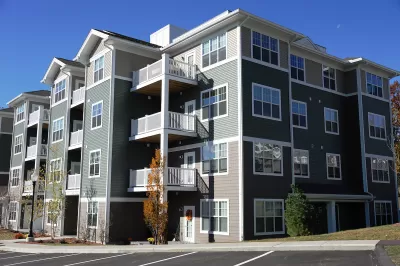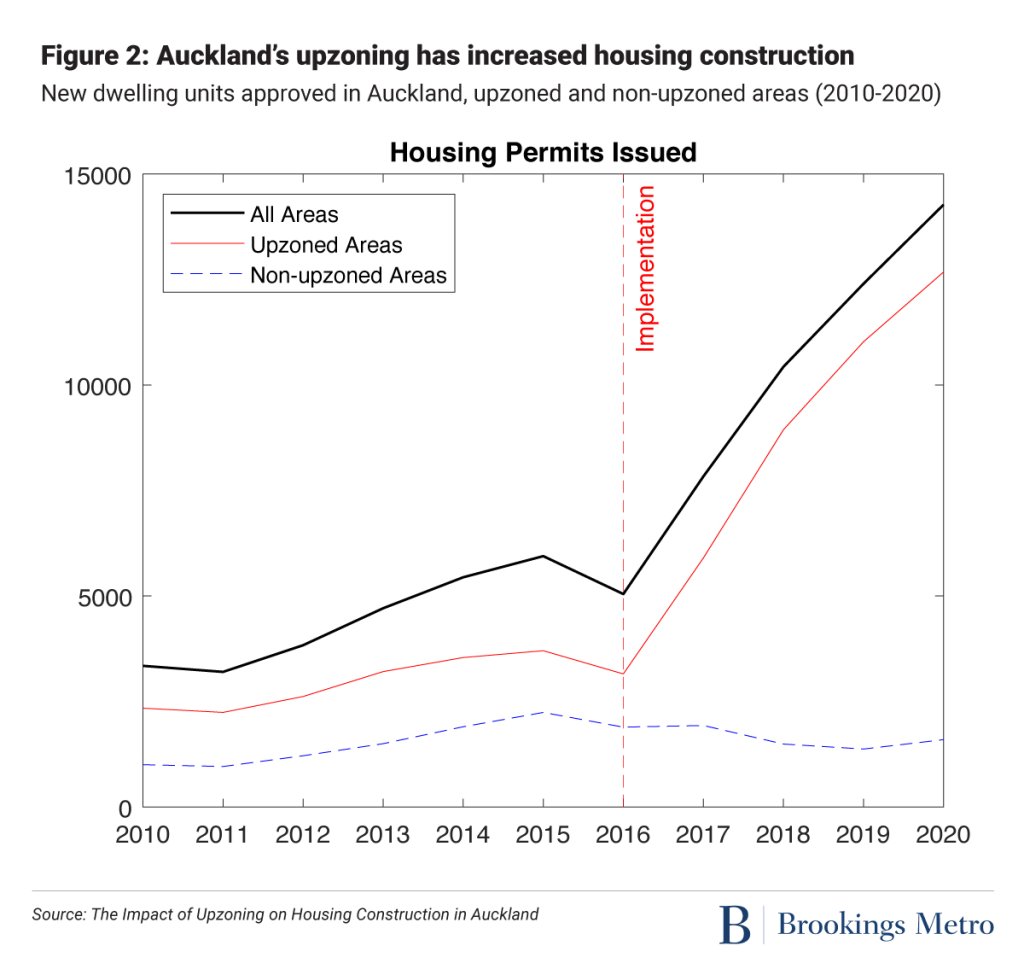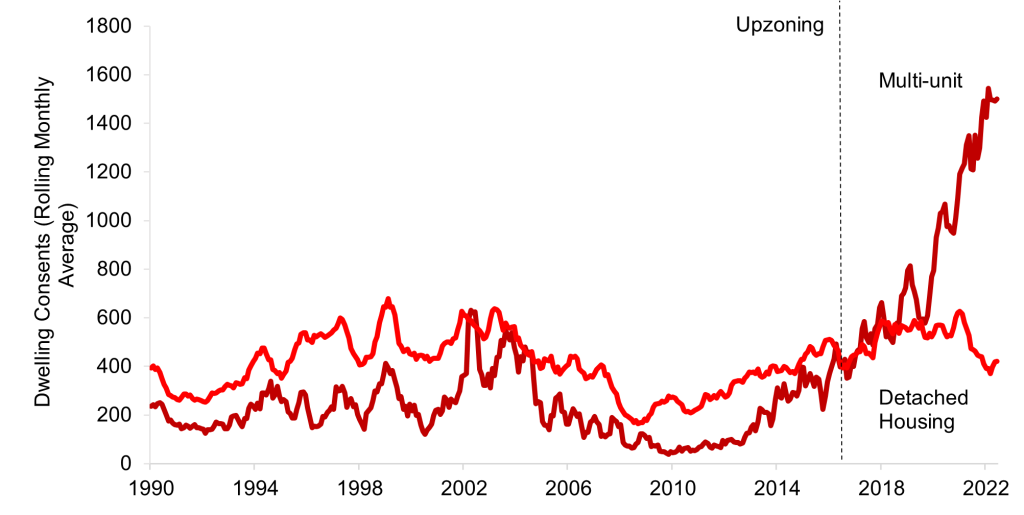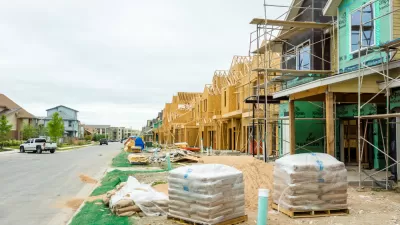There are new controversies concerning how upzoning affects housing supply and affordability, and new research to help planners understand these issues.

A controversy in planning concerns the degree that upzoning can increase affordability.
I reviewed this issue two years ago in Planetizen columns, The Housing Supply Debate: Evaluating the Evidence, and A Critical Review of 'Sick City: Disease, Race, Inequality and Urban Land', and in a Governing Magazine article, The Housing Affordability Recipe. Recent studies support the conclusion that broadly-applied upzoning that allows more compact housing types (townhouses, multiplexes, and multi-family) in multimodal neighborhoods, with complementary policies such as reducing parking minimums, can increase housing supply, drive down prices, and increase overall affordability.
This research has not prevented skeptics from arguing the opposite; that upzoning increases rather than reduces housing prices and reduces affordability. Such skepticism is understandable: housing prices tend to be higher in dense urban areas and a parcel's value tends to increase if it is upzoned. However, upzoning a large urban area has very different effect: it creates a competitive market for land prezoned for higher density housing which minimizes lane value increases, as discussed in UCLA Professor Shane Phillips' report, Building Up the "Zoning Buffer": Using Broad Upzones to Increase Housing Capacity Without Increasing Land Values.
Recent publications shed more light on these issues. NYU professors Vicki Been, Ingrid Gould Ellen and Katherine O’Regan just released Supply Skepticism Revisited, which updates their 2019 report, Supply Skepticism: Housing Supply and Affordability. They conclude that, "rigorous recent studies demonstrate that: 1) Increases in housing supply slow the growth in rents in the region; 2) In some circumstances, new construction also reduces rents or rent growth in the surrounding area; 3) The chains of moves sparked by new construction free up apartments that are then rented (or retained) by households across the income spectrum; 4) While new supply is associated with gentrification, it has not been shown to cause significant displacement of lower income households; and 5) Easing land use restrictions, at least on a broad scale and in ways that change binding constraints on development, generally leads to more new housing over time." However, they also conclude that upzoning alone cannot achieve affordability goals; it must be implemented with other policies,
Another study by the Urban Institute, Land-Use Reforms and Housing Costs: Does Allowing for Increased Density Lead to Greater Affordability? used an innovative research technique, machine-learning algorithms that read newspaper text, to identify where reforms increased or decreased allowed housing density, and estimated their impacts on housing supply and rents. They found that reforms that loosen restrictions are associated with a statistically significant increase in housing supply within three to nine years, consisting primarily of higher priced homes. Impacts on affordability were uncertain. Conversely, reforms that increase land-use restrictions and reduced allowed densities are associated with increased median rents and a reduction in units affordable to middle-income renters. This indicates to me that to increase affordability, upzoning should be implemented with policies that favor lower-priced housing, such as eliminating parking minimums and development fees for lower-priced units.
Another debate erupted in New Zealand when the Auckland Unitary Plan (the regional strategic plan) upzoned most residential neighborhoods. Analysis by researchers Ryan Greenaway-McGrevy and Peter Phillips, described in, New Zealand’s Bipartisan Housing Reforms Offer a Model to Other Countries, found that this resulted in a construction boom, which they illustrated with helpful graphs.

Economist Matthew Maltman, who analyzes the effects of upzoning in his webpage, Tracking the Revolution in Housing Policy, supports Greenaway-McGrevy and Phillips' findings in, Housing Supply in Auckland hits an Inflection Point.

A subsequent blog post by Cameron Murray and Tim Helm, "The Auckland Myth: There is no Evidence that Upzoning Increased Housing Construction," nitpicks Greenaway-McGrevy and Phillips' methodology and claims that “there is no evidence that upzoning increased construction.” Supply skeptics accept this as proof.
Greenaway-McGrevy produced an updated report, The Impact of Upzoning on Housing Construction in Auckland: Update and Extended Results that responded to Murray and Helm's criticism. Earlier this year Maltman posted, A Response to Murray and Helm on Auckland’s Upzoning, which points out errors and omission's in Murray and Helm's criticism. He state that "As far as I can tell, the extension paper deals with almost all of Murray and Helm’s concerns quite well. It shows that the original paper’s findings hold and are robust." and criticizes them for various omissions and biases that appear intended to discredit Greenaway-McGrevy and Phillips' research.
What does this mean for planners? It indicates that despite claims by skeptics, abundant credible research indicates that upzoning can increase housing supply and affordability, particularly if implemented with supportive policies such as parking development fees reforms that favor lower-priced housing development.
It also shows that this research will often be criticized. As described in my column, The Housing Supply Debate: Evaluating the Evidence, both freemarket advocates and supply skeptics tend to approach housing policy ideologically -- they are only interested in evidence that supports their preferred conclusions, and as Plaentizen editor James Brasuell described in, An Academic Debate with Very Real Consequences: Land Use Regulations and the Cost of Housing," they often severely misrepresent issues to score points. Planners must be prepared with better information.
FULL STORY: Supply Skepticism Revisited

Florida Considers Legalizing ADUs
Current state law allows — but doesn’t require — cities to permit accessory dwelling units in single-family residential neighborhoods.

Manufactured Crisis: Losing the Nation’s Largest Source of Unsubsidized Affordable Housing
Manufactured housing communities have long been an affordable housing option for millions of people living in the U.S., but that affordability is disappearing rapidly. How did we get here?

Research Shows More Roads = More Driving
A national study shows, once again, that increasing road supply induces additional vehicle travel, particularly over the long run.

EV Chargers Now Outnumber Gas Pumps by Nearly 50% in California
Fast chargers still lag behind amidst rapid growth.

Affordable Housing Renovations Halt Mid-Air Amidst DOGE Clawbacks
HUD may rescind over a billion dollars earmarked for green building upgrades.

Has Anyone at USDOT Read Donald Shoup?
USDOT employees, who are required to go back to the office, will receive free parking at the agency’s D.C. offices — flying in the face of a growing research body that calls for pricing parking at its real value.
Urban Design for Planners 1: Software Tools
This six-course series explores essential urban design concepts using open source software and equips planners with the tools they need to participate fully in the urban design process.
Planning for Universal Design
Learn the tools for implementing Universal Design in planning regulations.
City of Moreno Valley
Institute for Housing and Urban Development Studies (IHS)
City of Grandview
Harvard GSD Executive Education
NYU Wagner Graduate School of Public Service
City of Cambridge, Maryland
Newport County Development Council: Connect Greater Newport





























